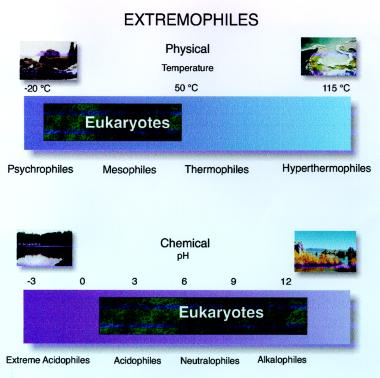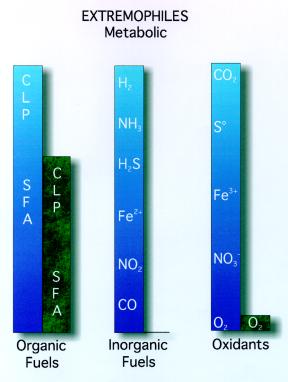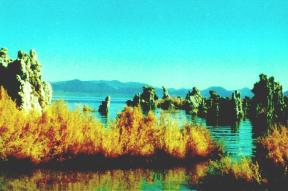ExtremophilesBut what about the toughness of prokaryotes? The word extremophile has crept into our vocabulary in the past decade: invented to describe organisms that are resistant to, and even thrive in, extreme conditions. As shown in the figure below, these extremophiles can be resistant to chemical (pH, salinity), physical (temperature, dryness), or nutritional extremes, and it is seldom in nature that an organism encounters just one extreme. For example, under high temperatures, it is common to find anoxic conditions, as the solubility of oxygen is very low in hot water. Furthermore, due to high evaporation rates, warm systems are often associated with high salinity. Thus, desert ponds are often of high pH and salinity, as evaporating water and the minerals trapped there interact to produce extreme conditions.
Figure 7. Extremophiles. This figure is designed to illustrate the ranges of environments encountered by various types of extremophiles, and to make the point that extreme conditions can be physical, chemical, or metabolic. It is seldom that one encounters just one of these conditions at a time. The most notorious extremophiles are perhaps those associated with high temperature environments - hyperthermophilic bacteria capable of growth at 100 C and above with a maximum temperature of about 115 C, well above the boiling point of water. These organisms can only be grown under pressure where the water is stable, and will freeze to death at temperatures as high as 80 C, temperatures that would result in severe burns to humans. Other bacteria are known that live in saturated salt brines, and at pH values as low as minus 3 and as high as 11. One of the strategies of life that often emerges when things get tough
is that of an endolithic lifestyle - the ability to associate with rocks, either
on or just under the surface. In
California’s alkaline Mono Lake, for example, we can see that the tufa mounds
that dominate the alkaline lake, and which appear to be dead, are actually
teeming with life (Figure 8).
Figure 8. Living in the rocks. This figure shows a layered community of organisms found in the tufa mounds (carbonate deposits) of Mono Lake, CA. This environment is characterized by high pH (about 10) and high salinity, but in the rock environment, above the water level, and shielded from the sun by the carbonate rocks, is a healthy and ubiquitous population of photosynthetic cyanobacteria, living in harmony with many other prokaryotic species. In addition to the physical and chemical extremes noted above, I would like to point out another property of prokaryotes, referred to here as nutritional extremophily. Given that eukaryotes are almost entirely limited to growth on organic carbon with oxygen as the oxidant, any set of conditions in which organic carbon or oxygen is absent is a potential life-threatening situation. For the prokaryotes, however, such environments are simply opportunities to continue living but with a different nutritional system. While it cannot be said with certainty when such metabolic diversity arose on Earth, its very existence forces one who is hunting for life to include such “extreme” habitats in the search, and to broaden the definition of life to include metabolic abilities that a few years ago, might have been summarily dismissed. The ability to grow on energy sources such as carbon monoxide, ferrous iron, hydrogen sulfide, or hydrogen gas, implies bacteria could inhabit worlds not previously considered as candidates by most scientists seeking extraterrestrial life, and must be included in any emerging search strategies.
Contributed by: Dr. Kenneth Nealson |









